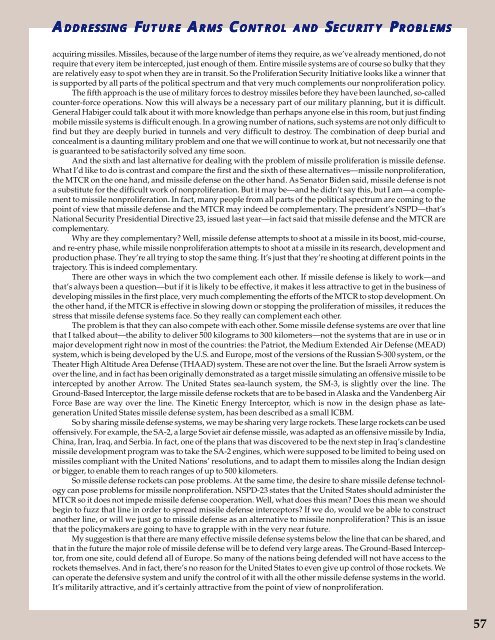test_pdf.pdf
Create successful ePaper yourself
Turn your PDF publications into a flip-book with our unique Google optimized e-Paper software.
ADDRESSING<br />
FUTURE<br />
ARMS<br />
CONTROL<br />
AND SECURITY<br />
PROBLEMS<br />
acquiring missiles. Missiles, because of the large number of items they require, as we’ve already mentioned, do not<br />
require that every item be intercepted, just enough of them. Entire missile systems are of course so bulky that they<br />
are relatively easy to spot when they are in transit. So the Proliferation Security Initiative looks like a winner that<br />
is supported by all parts of the political spectrum and that very much complements our nonproliferation policy.<br />
The fifth approach is the use of military forces to destroy missiles before they have been launched, so-called<br />
counter-force operations. Now this will always be a necessary part of our military planning, but it is difficult.<br />
General Habiger could talk about it with more knowledge than perhaps anyone else in this room, but just finding<br />
mobile missile systems is difficult enough. In a growing number of nations, such systems are not only difficult to<br />
find but they are deeply buried in tunnels and very difficult to destroy. The combination of deep burial and<br />
concealment is a daunting military problem and one that we will continue to work at, but not necessarily one that<br />
is guaranteed to be satisfactorily solved any time soon.<br />
And the sixth and last alternative for dealing with the problem of missile proliferation is missile defense.<br />
What I’d like to do is contrast and compare the first and the sixth of these alternatives—missile nonproliferation,<br />
the MTCR on the one hand, and missile defense on the other hand. As Senator Biden said, missile defense is not<br />
a substitute for the difficult work of nonproliferation. But it may be—and he didn’t say this, but I am—a complement<br />
to missile nonproliferation. In fact, many people from all parts of the political spectrum are coming to the<br />
point of view that missile defense and the MTCR may indeed be complementary. The president’s NSPD—that’s<br />
National Security Presidential Directive 23, issued last year—in fact said that missile defense and the MTCR are<br />
complementary.<br />
Why are they complementary? Well, missile defense attempts to shoot at a missile in its boost, mid-course,<br />
and re-entry phase, while missile nonproliferation attempts to shoot at a missile in its research, development and<br />
production phase. They’re all trying to stop the same thing. It’s just that they’re shooting at different points in the<br />
trajectory. This is indeed complementary.<br />
There are other ways in which the two complement each other. If missile defense is likely to work—and<br />
that’s always been a question—but if it is likely to be effective, it makes it less attractive to get in the business of<br />
developing missiles in the first place, very much complementing the efforts of the MTCR to stop development. On<br />
the other hand, if the MTCR is effective in slowing down or stopping the proliferation of missiles, it reduces the<br />
stress that missile defense systems face. So they really can complement each other.<br />
The problem is that they can also compete with each other. Some missile defense systems are over that line<br />
that I talked about—the ability to deliver 500 kilograms to 300 kilometers—not the systems that are in use or in<br />
major development right now in most of the countries: the Patriot, the Medium Extended Air Defense (MEAD)<br />
system, which is being developed by the U.S. and Europe, most of the versions of the Russian S-300 system, or the<br />
Theater High Altitude Area Defense (THAAD) system. These are not over the line. But the Israeli Arrow system is<br />
over the line, and in fact has been originally demonstrated as a target missile simulating an offensive missile to be<br />
intercepted by another Arrow. The United States sea-launch system, the SM-3, is slightly over the line. The<br />
Ground-Based Interceptor, the large missile defense rockets that are to be based in Alaska and the Vandenberg Air<br />
Force Base are way over the line. The Kinetic Energy Interceptor, which is now in the design phase as lategeneration<br />
United States missile defense system, has been described as a small ICBM.<br />
So by sharing missile defense systems, we may be sharing very large rockets. These large rockets can be used<br />
offensively. For example, the SA-2, a large Soviet air defense missile, was adapted as an offensive missile by India,<br />
China, Iran, Iraq, and Serbia. In fact, one of the plans that was discovered to be the next step in Iraq’s clandestine<br />
missile development program was to take the SA-2 engines, which were supposed to be limited to being used on<br />
missiles compliant with the United Nations’ resolutions, and to adapt them to missiles along the Indian design<br />
or bigger, to enable them to reach ranges of up to 500 kilometers.<br />
So missile defense rockets can pose problems. At the same time, the desire to share missile defense technology<br />
can pose problems for missile nonproliferation. NSPD-23 states that the United States should administer the<br />
MTCR so it does not impede missile defense cooperation. Well, what does this mean? Does this mean we should<br />
begin to fuzz that line in order to spread missile defense interceptors? If we do, would we be able to construct<br />
another line, or will we just go to missile defense as an alternative to missile nonproliferation? This is an issue<br />
that the policymakers are going to have to grapple with in the very near future.<br />
My suggestion is that there are many effective missile defense systems below the line that can be shared, and<br />
that in the future the major role of missile defense will be to defend very large areas. The Ground-Based Interceptor,<br />
from one site, could defend all of Europe. So many of the nations being defended will not have access to the<br />
rockets themselves. And in fact, there’s no reason for the United States to even give up control of those rockets. We<br />
can operate the defensive system and unify the control of it with all the other missile defense systems in the world.<br />
It’s militarily attractive, and it’s certainly attractive from the point of view of nonproliferation.<br />
57<br />
57
















